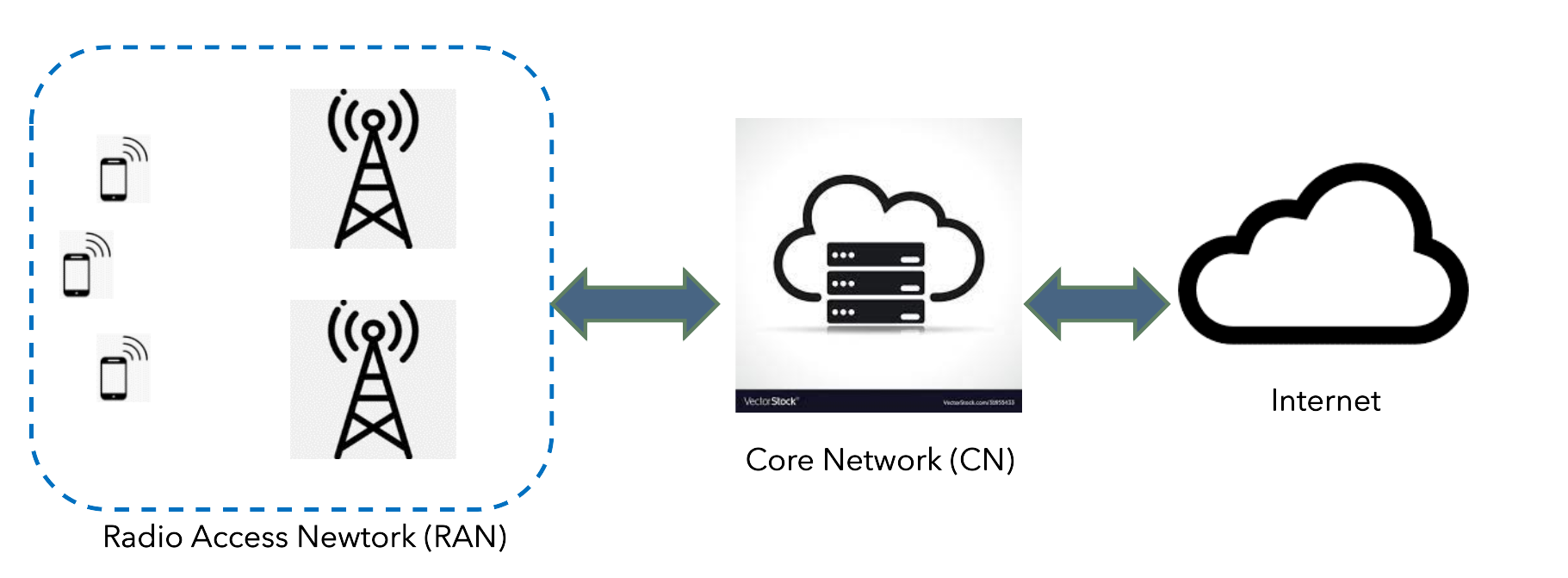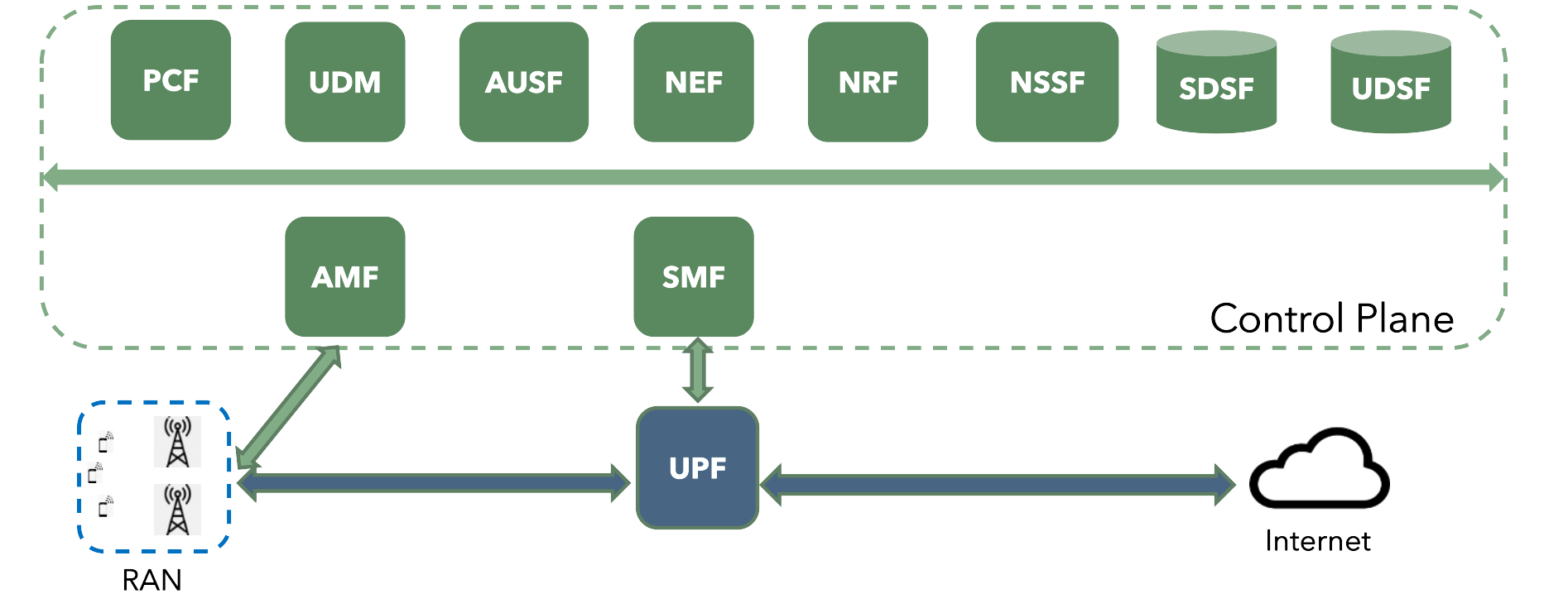System Architecture
Here we will identify the main architectural components of the 5G newtork, function of each component and how they interact with each other at the system level.
5G Network
A cellular network provides wireless connectivity to devices that are on the move. These devices, which are known as User Equipment (UE), include smartphones, cars, drones, industrial and agricultural machines, robots, home appliances, medical devices etc.
The cellular network consists of two main subsystems:
-
Radio Access Network (RAN): The RAN manages the radio spectrum, making sure it is used efficiently and meets the quality-of-service requirements of every user. It corresponds to a distributed collection of base stations wach of which is known as a gNB (The g stands for “next Generation”). All UEs that are near the gNB are served by that gNB, making them part of the RAN
-
Mobile Core: The Mobile Core, also known as the Core Network is a bundle of functionality (as opposed to a device) that serves several purposes:
-
Provides Internet (IP) connectivity for both data and voice services
-
Ensures this connectivity fulfills the promised QoS requirements
-
Tracks user mobility to ensure uninterrupted service
-
Tracks subscriber usage for billing and charging
-
RAN (Radio Access Network)
The RAN consists of two entitites:
-
User Equipment (UE)
These are mobiel devices that are granted wireless network connectivity by the 5G network. The most well known type of UE is a mobile phone. However, especially after the introduction of 5G, many devices can act as UEs. These include smart watches, sensors, connected vehicles, etc. Any device which can use the radio spectrum to communicate with a gNB can be a UE.
-
gNodeB (gNB)
These are the base stations, or radio access towers, which transmit data wirelessly to mobile devices using the radio spectrum. 5G base stations are known as gNBs, and are equipped with the latest wireless communication technology to enable the best quality wireless connectivity with surrounding UEs.
5G Mobile Core
The 5G core network architecture is at the heart of the new 5G specification and enables the increased throughput demand that 5G must support. The new 5G core, as defined by 3GPP, utilizes cloud-aligned, service-based architecture (SBA) that spans across all 5G functions and interactions including authentication, security, session management and aggregation of traffic from end devices. The main function of the Mobile Core is to provide external packet data network (i.e., Internet) connectivity to mobile subscribers, while ensuring that they are authenticated and their observed service quality requirements are met. The 5G core further emphasizes network function virtualization (NVF) as an integral design concept with virtualized software functions capable of being deployed using the Multi-access Edge computing (MEC) infrastructure that is central to 5G architectural principles.
The core network is simply a collection of functions which are required to provide the abovementioned services. Each 'function' carries out a specific set of jobs that are needed for the 5G network to function.
The function that users will use the most frequently runs in the 'User Plane':
- UPF (User Plane Function): Forwards traffic between RAN and the Internet, corresponding to the S/PGW combination in EPC. In addition to packet forwarding, it is responsible for policy enforcement, lawful intercept, traffic usage reporting, and QoS policing.
There is another set of functions that manages functions such as user authentication, session management, and policy implementation for the 5G network operators. This group runs in the Control Plane (CP):
-
AMF (Core Access and Mobility Management Function): Responsible for connection and reachability management, mobility management, access authentication and authorization, and location services.
-
SMF (Session Management Function): Manages each UE session, including IP address allocation, selection of associated UP function, control aspects of QoS, and control aspects of UP routing.
-
PCF (Policy Control Function): Manages the policy rules that other CP functions then enforce.
-
UDM (Unified Data Management): Manages user identity, including the generation of authentication credentials.
-
AUSF (Authentication Server Function): Essentially an authentication server.
The final group also runs in the Control Plane (CP), and are all functions that have been introduced in the 5G standard:
-
SDSF (Structured Data Storage Network Function): A “helper” service used to store structured data. Could be implemented by an “SQL Database” in a microservices-based system.
-
UDSF (Unstructured Data Storage Network Function): A “helper” service used to store unstructured data. Could be implemented by a “Key/Value Store” in a microservices-based system.
-
NEF (Network Exposure Function): A means to expose select capabilities to third-party services, including translation between internal and external representations for data. Could be implemented by an “API Server” in a microservices-based system.
-
NRF (NF Repository Function): A means to discover available services. Could be implemented by a “Discovery Service” in a microservices-based system.
-
NSSF (Network Slicing Selector Function): A means to select a Network Slice to serve a given UE. Network slices are essentially a way to partition network resources in order to differentiate service given to different users. It is a key feature of 5G that we discuss in depth in a later chapter.
Together, all these components make up the core network of the 5G mobile network. They work together to handle:
-
Connection setup, authentication, authorization, and localization
-
User session management
-
Data routing and transfer
-
New functions introduced in 5G such as network slicing, APIs, and service discovery

